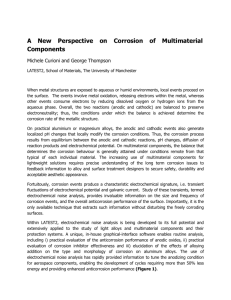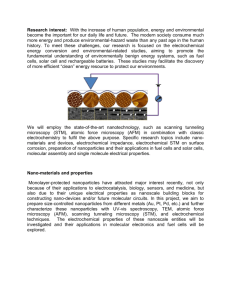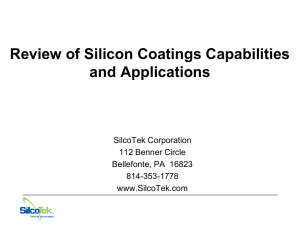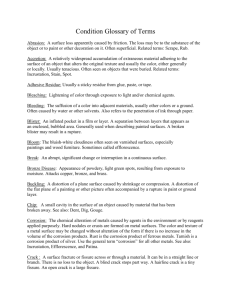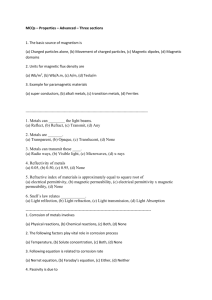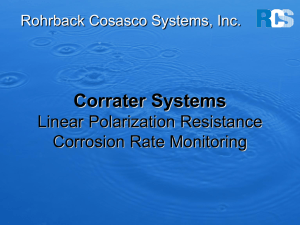T E M P L A T E Non-destructive technique for evaluation of
advertisement
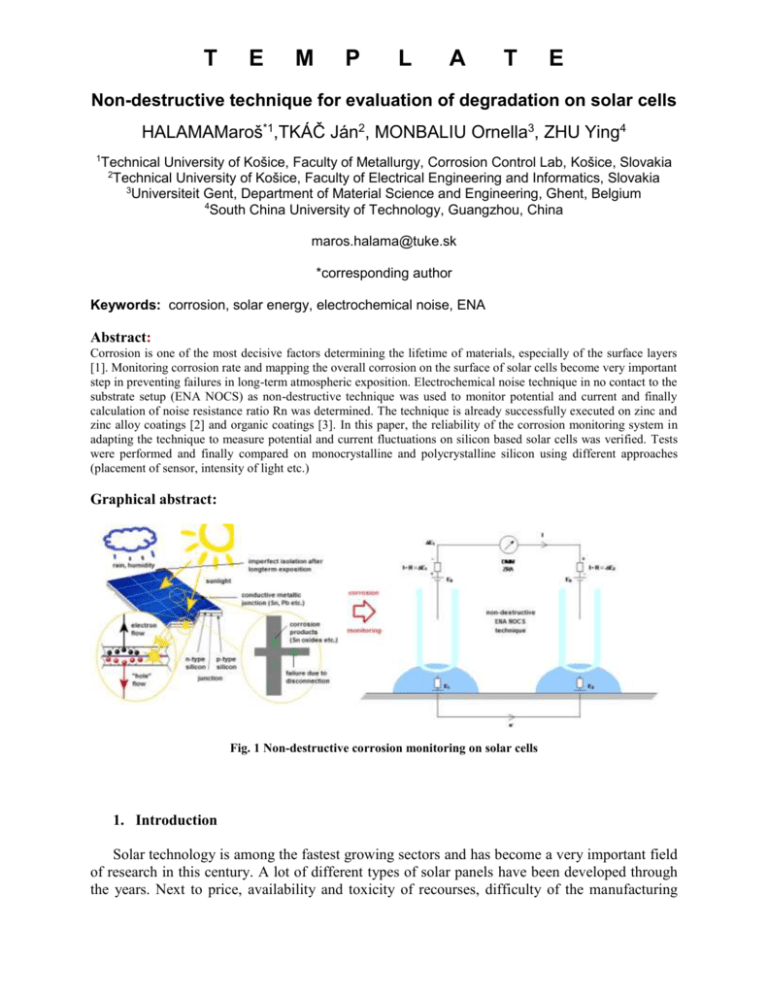
T E M P L A T E Non-destructive technique for evaluation of degradation on solar cells HALAMAMaroš*1,TKÁČ Ján2, MONBALIU Ornella3, ZHU Ying4 Technical University of Košice, Faculty of Metallurgy, Corrosion Control Lab, Košice, Slovakia 2 Technical University of Košice, Faculty of Electrical Engineering and Informatics, Slovakia 3 Universiteit Gent, Department of Material Science and Engineering, Ghent, Belgium 4 South China University of Technology, Guangzhou, China 1 maros.halama@tuke.sk *corresponding author Keywords: corrosion, solar energy, electrochemical noise, ENA Abstract: Corrosion is one of the most decisive factors determining the lifetime of materials, especially of the surface layers [1]. Monitoring corrosion rate and mapping the overall corrosion on the surface of solar cells become very important step in preventing failures in long-term atmospheric exposition. Electrochemical noise technique in no contact to the substrate setup (ENA NOCS) as non-destructive technique was used to monitor potential and current and finally calculation of noise resistance ratio Rn was determined. The technique is already successfully executed on zinc and zinc alloy coatings [2] and organic coatings [3]. In this paper, the reliability of the corrosion monitoring system in adapting the technique to measure potential and current fluctuations on silicon based solar cells was verified. Tests were performed and finally compared on monocrystalline and polycrystalline silicon using different approaches (placement of sensor, intensity of light etc.) Graphical abstract: Fig. 1 Non-destructive corrosion monitoring on solar cells 1. Introduction Solar technology is among the fastest growing sectors and has become a very important field of research in this century. A lot of different types of solar panels have been developed through the years. Next to price, availability and toxicity of recourses, difficulty of the manufacturing T E M P L A T E process, the efficiency of the solar cell is also a very important property. Direct conversion of sunlight into electricity and heat is carried out on thin films of high purity materials equipped with suitable physical properties. These materials are very sensitive to external operational factors that cause degradation of optical, chemical and electrical properties. Corrosion on the surface of a solar cell may influence the overall efficiency [1OMReport]. Corrosion is one of the decisive factors influencing the lifetime of metallic materials, especially of surface layer due to the interaction with environment via humidity, presence of contaminants, ultraviolet radiation….. Electrochemical noise One of the numerous electrochemical techniques to analyze corrosion behavior of coatings is Electrochemical Noise Analysis (ENA) in NOCS setup as non-destructive technique using 3electrodes, of which one is working electrode and two are reference electrodes. By measuring the current between the two working electrodes at regular intervals, the potential and current data are obtained. The parameter representing the corrosion resistance is the noise resistance Rn, which is calculated as: 𝑅𝑛 = 𝑆𝑡𝑑𝑒𝑣 𝐸 𝑆𝑡𝑑𝑒𝑣 𝐼 Where Stdev E is the standard deviation of the potential and Stdev I the standard deviation of the current. Next to the noise resistance, the technique also allows computation of the pitting index ratio. The pitting index ratio is calculated as: 𝑷𝑰 = 𝑺𝒕𝒅𝒆𝒗 𝑰 𝑹𝑴𝑺 𝑰 where RMS Iis the root mean square value of the measured current i. By this pitting index ratio, the type of corrosion that is present on the sample can be determined. Experimental For measurements of electrical noise, an experimental setup was developed (Fig. ). Two electrodes are placed on the top of the sample in the sample holder filled with SARS solutions (0.01 M HNO3, 0.001M NaCl and 0.001M (NH4)2SO4. These electrodes are connected to a source and whole set-up is protected against fluctuations from environment by a Farraday cage. T E M P L A T E Fig. 1 Schematic representation of electric setup of NOCS ENA [ ] Measurements of potential and current wererealizedin 2 minutes monitoring separately. For current measurements a resistance of 1 or 100 MOhms is added in the circuit, dependent on the order of magnitude of the current values. The measured data are processed in programme NoiseJazz2012 for statistical evaluation and visualization of corrosion activity/passivity. The technique was already successfully executed on zinc coatings and organic coatings on zinc. Here, the new challenge is to adapt the technique to measure potential and current fluctuations on silicon based solar cells. Due to the fact that corrosion rate is influenced by several factors such as humidity, light intensity, temperature, concentration of pollutants etc., tests were executed on polycrystalline sample at different light intensities. The blackbox measurement tends to have higher corrosion resistance compared to measurements at increased light conditions..………….. Experimental Set of two series of samples were used, all composed of mainly silicon with thin metallic lines for transport of the electrons. These thin lines are mutually connected by thicker metallic strips (see also Figure …). Samples were detected by Scanning Electron Microscopy (SEM) and chemical analysis of the different parts were examined using Energy-Dispersive X-ray spectroscopy (EDX). T E M P L A T E The SEM-images of the monocrystalline silicon-based solar panel are shown in Figure .. . An EDX analysis shows the chemical composition of specific parts of the sample. An overview of the different spectra of the metal parts is depicted in Figure 10 . In Figure 10 a , the composition of the thick metal strip is shown. Next to a majority of tin, the metal band also contains presence of lead and oxygen. For the thin band, the chemical composition is similiar (Figure… ). Fig. 2 SEM-image and EDX analysis of the boundary metallic part/monocrystalline silicon based solar panel …………… Conclusions: A corrosion monitoring system based on no contact to the substrate setup of electrochemical noise analysis tested on the surface of silicon solar cells in pilot experiments showed big influence of light intensity on detection of corrosion activity on metallic components made of Pb and Sn. However, there is a need to look at other practical consideration of making non-destructive ENA measurements suitable for assessment of efficacy of charge transfer during long-term exposition. There is a big potential to observe problematic parts of photovoltaic cells caused by chemical and electrochemical degradation by corrosion monitoring technique, all before visual inspection get results. T E M P L A T E Acknowledgment: This work was realized within the frame of the Operational Program Research and Development: "Research Center for renewable energy resources integration and performance efficiency", project code ITMS: 26220220064 and financially supported by the European Regional Development Fund and also within the frame of the Operational Program Research and Development: “Research Center of advanced materials and technologies for current and future applications - PROMATECH”, project code ITMS: 26220220186. References: [1] http://www.photovoltaikbuero.de [2] Halama, M., Kreislova, K., Lysebettens, J. V.: Prediction of Atmospheric Corrosion of Carbon Steel Using Artificial Neural Network Model in Local Geographical Regions, In: Corrosion: The Journal of Science and Engineering, Vol. 67, no. 6 (2011), p. 1-6, ISSN 00109312 [3] Halama, M., Zhu Y., Kovaľ, K., Brezinová, J.: Quantification of corrosion activity on HDG steel sheets during cyclic dip tests in classical and ecological salt solutions, In: Acta Metallurgica Slovaca, Vol. 20 (2014) pp. 89-96 [4] Mabbut, S., Mills, D.J., Woodcock, C.P.: Developments of the electrochemical noise method for more practical assessment of anti-corrosion coatings, In: Progress in Organic Coatings, Vol. 59 (2007) [5] Mansfeld, F., Xiao, H., Wang, Y.: The use of electrochemical impedance spectroscopy (EIS) and electrochemical noise analysis (ENA) for monitoring of biocorrosion, In: Conference proceedings: Tri-service conference on corrosion, Orlando, Florida, 1994 [6] M. Halamaet. al.: Active corrosion management in automotive industry: hyphenation of electrochemical noise analysis with artificial neural networks – feasibility study, EUROCORR 2009 – The European Corrosion congress, 6.-10.9.2009, Nice [7]Monbaliou, O.: Report IAESTE stage, 2013 IMPORTANT! Limit for CSTI2015 Special edition of Material Science Forum is 4 pages.

